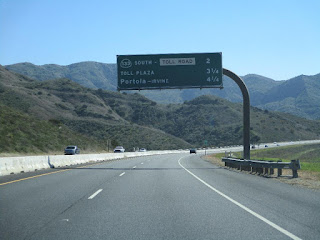Part 1; the history of California State Route 241
The current California State Route 241 (CA 241) is the third corridor to carry the designation. The original corridor to be assigned as CA 241 was part of the 1964 California State Highway Renumbering. The original CA 241 corridor was the planned Eastern Bypass which was defined as "Route 11 near Adams Street to Route 11 near Elysian Park in Los Angeles." The original planned CA 241 corridor can be observed on the 1964 Division of Highways Map.
The original CA 241 Eastern Bypass corridor had been adopted into the State Highway System as Legislative Route Number 222 (LRN 222) as part of 1947 Legislative Chapter 11. LRN 222 first appears on the 1948 Division of Highways Map.
The original CA 241 corridor was reappealed via 1965 Legislative Chapter 1372. The original planned corridor of CA 241 is shown as vacant on the 1966 Division of Highways Map.
1968 Legislative Chapter 282 transferred the planned route of Interstate 80 (the Panhandle Freeway) from "Route 1 to Route 101 near Fell and Oat Streets" in San Francisco as the second CA 241. The second CA 241 first appears on the 1969 Division of Highways Map.
1972 Legislative Chapter 1216 deleted the second corridor of CA 241. The second corridor of CA 241 appears as vacant on the 1975 Caltrans Map.
During 1986 the Transportation Corridors Agencies (TCA) of Orange County were created. Corridors governed by the TCA included: the Eastern Transportation Corridor, Foothill Transportation Corridor and San Joaquin Hills Transportation Corridor. 1987 Legislative Chapter 1413 allowed for transportation corridors to be constructed by way of toll funds.
The current CA 241 was defined as part of 1988 Legislative Chapter 1363 as "Route 231 near the Cities of Tustin and Irvine to Route 5 south of San Clemente." The planned corridor of the third CA 241 appears on the 1990 Caltrans Map.
As originally defined the current CA 241 only included the Foothills Transportation Corridor of the Orange County Transportation Corridor System. The Foothills Transportation Corridor is subdivided into the Foothill-North and Foothill-South segments. The Foothill-North segment of the Foothills Transportation Corridor spans from the current junction of CA 133 south to Oso Parkway. CA 241 between Portola Parkway in Irvine south to Antonio Parkway in Rancho Santa Margarita initially opened in two segments: a 3.2-mile segment on October 16th, 1993 and a 4.3-mile segment on April 7th, 1995.
1996 Legislative Chapter 1154 extended CA 241 north via transfer from CA 231. The new definition of CA 241 retained its southern terminus, but the northern terminus was reassigned as "Route 91 in the City of Anaheim. The new segment of CA 241 north of CA 133 which was absorbed from CA 231 is the Eastern Transportation Corridor.
According to AAroads the next segments of CA 241 to open came in 1998. This included northernmost end of the Foothill-North segment to CA 133 in addition to the eastern Transportation Corridor north to CA 91. CA 241 was extended south to Oso Parkway in 1999 which completed the Foothill-North segment.
Beginning in 2000 the process to select a planned alignment of CA 241 via the Foothill-South segment to Interstate 5 began. Attempts to extend CA 241 south to Interstate 5 have met heavy resistance in the past two decades. Development of CA 241 on the Foothill South segment was dealt a serious obstruction when Governor Gavin Newsom signed Assembly Bill Number 1426 on September 25th, 2020. Assembly Bill Number 1426 effectively blocked CA 241 from being constructed to Interstate 5 at San Onofre State Beach.
During April 2021 the City of San Clemente voted to pursue removing itself from TCA. The vote by the City of San Clemente stemmed from two pieces of Legislation initiated by Patricia Bates. One pieces of Legislation would have the definition of CA 241 truncated to Oso Parkway while the second would provide protections for open spaces within the City of San Clemente which could have been purposed for the Foothill South segment.
CA 241 in its current form appears on the 2005 Caltrans Map.
CA 241 southbound begins from westbound CA 91 Exit 41B in Anaheim.
























































Comments